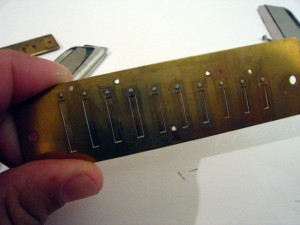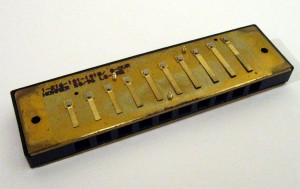
Let’s do a little experiment or two. You will need some paper clips, a pencil, and a ruler.
Take one of the paper clips and bend it out straight. Now bend it sharply back and forth. Keep bending it back and forth. Eventually, it will break. It breaks because of something called metal fatigue. Like the paper clip, harmonica reeds are bent back and forth hundreds of times per second. Eventually, they will suffer the fate of your paper clip.
Take a second paperclip and bend it back and forth, but not as sharply as you did the first time. Notice that it takes longer to break.
When you play hard, the harmonica is louder because the reeds are swinging farther as they go back and forth than if you were playing lightly. Like the first paper clip you bent sharply, reeds played hard will go out much faster.
Not only do your reeds go out faster, you lose tone. Most of the great players played very softly and used their natural resonance by relaxing their embouchure to project tone and volume. Junior Wells is a very good example of someone who seems to be playing hard, but doesn’t.
So Why Do Your Reeds Go Out?
There are several stresses working on a reed; the two we will discuss now are compression stress and tension stress. Compression stress crushes stuff. Tension stress tears stuff. There is another type of stress that makes overblows squeal, but that’s the subject for another post.
You can see a good example of this with your pencil. Bend your pencil until it just starts to break, but is still in one piece. You will notice that one side breaks first. That is where your tension stress was most concentrated. It literally rips the pencil’s wood apart. The opposite side of the pencil is under compression stress.
Now the ruler. Hold it firmly and vertically in one hand, with a flat side facing you. Bend it back and forth to mimic the movement of a reed. Bend your ruler toward you and stop. At this point in the ruler/reed’s swing, the compression force is working to crush the side of the ruler that faces you.
Let go of the ruler. It’s standing up straight. Now, it is under no stress whatsoever.
Bend the ruler away from you. Now, the stresses are reversed from how they were the first time. The side facing you is under tension stress, while the side away from you is under compression stress.
Each side of your reed goes through this same cycle (compression stress > no stress > tension stress) hundreds of times a SECOND – and these forces increase as the reed swings farther out. When you play hard, the reed swings out farther, the stresses are magnified, and the reed goes out sooner.
Ok, so Now You Know Why They Break. Here’s How:

Each side of a reed looks very different. One side is shiny and smooth. The other side has horizontal marks all the way up and down the reed. These are called milling marks – basically scars from the process of grinding a sheet of brass into something reeds can be cut from. These marks are like weak links in a chain. Reeds always break along these marks.
It starts with a little crack. Break another pencil if you need a refresher. Right before your pencil breaks, you hear a crack. When a reed starts to go out, it begins with a little crack – the kind you would see in a sidewalk, not the kind you hear – along a milling mark. The crack starts at the edge of the reed and works its way across.
Why the crack makes your reed go flat is beyond the scope of this post, but it does. First the crack doesn’t get any deeper; it just goes across, and the reed goes flatter over time. As it goes flatter, you can usually retune it and get some more life from it.
But, you can do this for only so long. At first, the reed goes flat slowly, but then suddenly it drops in pitch a half step or more and cannot be tuned back.
Once the crack goes all the way across, it’s a different story. Now there’s a significant defect, and it has to do with how the stress is distributed within the reed.
We’ll use the ruler to illustrate again. Hold it like before and bend it toward you and stop.
Let’s pretend we can shrink ourselves to microscopic size and drill our way into the side of the ruler facing you and come out the other side. As we land on the side of the ruler facing you, the surface is under an enormous amount of compression stress. As we drill and go into the ruler that compression stress decreases until we reach a point where there is no stress whatsoever. As we go into the other side – the side facing away – we run into tension stress. As we near the surface of the other side, the tension stress increases greatly. When you bend the ruler away from you, the stresses are reversed.
So we know the tension stress is greatest on the surface of the reed. When the crack is small and hasn’t gone all the way across, there is still metal on the surface to hold it together.
Bend another pencil until it breaks. You’ll notice first the audible crack, but once it breaks, it does so all at once. Reeds are the same way. Once that crack has worked its way across, the reed, like the pencil, breaks very quickly.

Comments
Got something to say? Post a comment below.